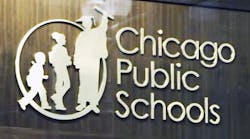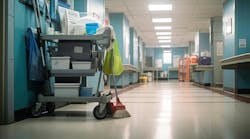Operating facilities more efficiently is always a worthwhile goal, but when education budgets are shrinking, the quest for efficiency becomes a necessity. In the funding climate that schools and universities find themselves, building managers will be fortunate to hang on to the budget they have, let alone receive the resources they need to address short- and long-term school maintenance requirements.
Economic forecasts indicate that education funding is not likely to return to pre-recession levels in the next year or two. That means the only avenue for most school maintenance and operations staff to keep facilities in good condition is to try to stretch their dollars and do more with less. And in some cases, until more money is available, school maintenance staffs might be forced in the short term to do less.
Slow recovery
The National Governors Association and the National Association of State Budget Officers’ Spring 2011 Fiscal Survey of States says that the financial condition of most states is better than it has been in the last couple of years, but is not back to where it was before economic conditions took a nose dive in 2008. The survey found that states’ general fund spending is projected to climb to $669 billion in fiscal 2012. That’s a rebound from $619 billion in fiscal 2010, but remains $18 billion less than the $687 billion states spent in fiscal 2008.
"Spending and revenue collections are unlikely to return to prerecession levels for a couple more years in a number of states," the report says. "The slow economic recovery and the wind down of Recovery Act funding in fiscal 2012 will continue to present states with an environment of tight fiscal conditions."
State revenue collections show a similar pattern. They are projected to increase in fiscal 2012, to $656 billion, but that is below the $680 billion collected in fiscal 2008.
"State general revenue collections remain below their 2008 highs, even after two consecutive annual increases," the survey found.
Unappealing Choices
Even in prosperous times, school maintenance and operations needs take a back seat to spending more directly linked to classroom instruction, and education institutions have continually searched for ways to operate facilities more efficiently. But having already reaped many of the opportunities to save money through more efficient operations while still facing significant spending cuts, many schools have had to scale back their maintenance efforts.
A December 2010 report by the American Association of School Administrators (AASA), "Surviving a Thousand Cuts: America’s Public Schools and the Recession," delineates some of the strategies school districts have had to pursue because of dwindling budgets:
•Deferred maintenance. For the 2010-11 school year, 52 percent of districts put off some maintenance projects; 60 percent of districts expect to do so in 2011-12.
•Heating and cooling. In 2010-11, 63 percent of school districts say they adjusted thermostats to provide less heating and cooling in their facilities; 55 percent expected to do so in 2011-12.
•Less service. A total of 37 percent of districts say they reduced custodial services in 2010-11, and 45 percent of districts say they expect to reduce service in 2011-12.
•Outsourcing. For the 2010-11 school year, 9 percent of districts outsourced custodial and maintenance work; 21 percent anticipate doing so in 2011-12.
•Reduced operations. Twenty-five percent of districts reported that they went to a four-day work week during summer 2010; 35 percent expect to do so for summer 2011. During the school year, 6 percent say they adopted a four-day school week, and 17 percent say they expected to do so in 2011-12. Curtailing summer school and extracurricular activities also can reduce facility operation costs. The AASA survey found that 27 percent of districts eliminated summer school programs in 2010-11, and 40 percent expected to do so in 2011-12. Thirty-one percent scaled back extracurricular activities in 2010-11, and 52 percent expect to reduce activities in 2011-12.
•Closing schools. Eight percent of districts say they closed or consolidated school facilities in 2010-11, and 15 percent anticipated that they would close schools in 2011-12.
Seeking Efficiency
If their resources permit, schools and universities should resist the temptation to gain short-term savings by forgoing preventive or predictive maintenance. Carrying out upkeep of facilities and equipment at regular intervals will enable education institutions to avoid premature breakdowns and prolong the useful life of building systems.
As part of its mission to create affordable, sustainable and energy-efficient school facilities in the state, the Massachusetts School Building Authority (MSBA) has put together a list of best practices for school systems to follow as they maintain their buildings. Some of the recommendations:
•Work-order system. "Whether the job originates as a problem communicated by building users or as part of planned maintenance projects, a work-order system provides uniformity in planning maintenance jobs," the MSBA says. "Using work orders for upcoming preventive maintenance tasks helps schedule the work so that it does not get neglected amidst multiple maintenance jobs."
Using a computerized system to manage the maintenance work enables education institutions to carry out jobs even more efficiently and provides a database for administrators to analyze how effective the maintenance operation is functioning.
•Facilities Condition Index. The MSBA encourages school systems to create a database that details the components and characteristics of all of their buildings. Such an inventory gives administrators the facts they need to determine whether repairing or replacing facilities or systems is more cost-effective.
•Inspections. "Preventive maintenance is facilitated by an inspection program that is conducted on a regular basis," the MSBA says. Having a standardized list of components to be included in inspections makes it more likely that the inspectors will collect consistent information and carry out the inspections thoroughly.
•Commissioning. This process ensures that building elements are installed and operating as intended. The MSBA says that under ideal circumstances, a school system should commission new buildings as well as existing buildings following a substantial renovation. Recommissioning should take place five years after the initial commissioning, and systems should be retested on a five-year cycle. Older buildings should undergo "retro-commissioning" to see that their systems are optimized to meet operational needs.
Kennedy, staff writer, can be reached at [email protected].



